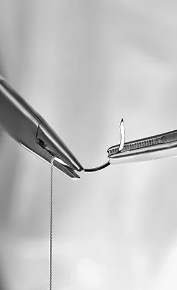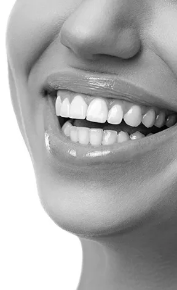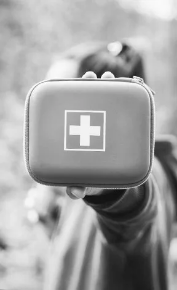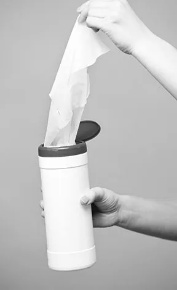Regenerative Biomaterials
View answers to our most asked questions about Regenerative Biomaterials
Bone Grafts
Composition of PentOS OI™ Flex. PentOS OI™ Flex is made of demineralized, osteoinductive 100% cortical bone.
The five elements of bone formation with PentOS OI™ Flex, PentOS OI™ Max, PentOS OI™ Putty and PentOS OI™ Sponge. Post sterilization in-vivo testing is performed on each batch, and each batch must demonstrate the presence of new bone, bone marrow, osteocytes, cartilage and chondrocytes within 28 days in an athymic rat model. If not, they do not call it PentOS OI™
PentOS OI™ Max is made from 100% human allograft demineralized bone matrix and is cortical bone.
If primary closure is not possible, the use of a membrane is highly recommended. Normally, a dental membrane is used to prevent the epithelial cells from growing into the bone graft site, where new bone is forming. A Neomem® membrane also helps to keep the granules at the graft sight, preventing migration of the granules. A membrane is also used when primary closure is not possible. However, if the periosteum is still intact, it can be used to achieve primary closure. If the periosteum is damaged in any way, a membrane, such as Neomem® or Neomem® FlexPlus, should be used.
Many advantages of using the PentOS OI™ Max
- Mixed PentOS OI™ Max can be extruded through a syringe.
- It resists copious irrigation and has a five-year shelf life at ambient storage.
- Shown to form bone post-sterilization in-vivo.
- Demonstrates osteoconductivity.
- It can be used in patients with compromised immune systems, older patients and those who have more difficulty growing new bone.
- Up to 40x native BMP vs the BMP-2 control
- Each batch histologically demonstrates all five elements of bone formation pH balanced – non cytotoxic.
- Shown to form bone post-sterilization in-vivo
The features of PentOS OI™
There are many benefits to using PentOS OI™ Putty:
- Verified to be osteoinductive Osteoconductive
- Excellent handling characteristics
- Resists irrigation
- Sterilized using low-dose gamma irradiation
- Ready to use Stored at room temperature
You can use any grafting material at the site but you may wish to use a putty to help keep the graft material contained.
Available options:
- Raptos® DBM100 100% Allograft Putty
- PentOS OI™ Putty 100% Allograft Putty
- C-Graft Putty™ Allograft + Plant Derived Carrier
- C-Blast Putty™ Allograft + Plant Derived Carrier + Cancellous bone chips
- Eclipse™ Putty Synthetic Graft (Hydroxyapatite (HA), Beta Tricalcium Phosphate (ß-TCP) and a hydrogel)
PentOS OI™ Sponge can be trimmed with scissors, rongeurs or a scalpel, however you will want to hydrate the sponge before trimming. Hydrating the it allows you to trim the sponge to the exact size needed to avoid chipping off any areas of the sponge you may want to keep.
There are many applications for PentOS OI™ Putty:
- Periodontal defects
- Implant site development
- Coronal defects around immediate implants
- Extraction site repair
- Implant dehiscence defects
- Sinus lift procedures
- Moderate localized ridge defects
Yes, PentOS OI™ Putty is sterilized using low-dose gamma irradiation
PentOS OI™ Putty is made from 100% human bone without any additional diluent or carriers to diminish its osteoinductive properties.
You can use PentOS OI™ Putty in an orbital floor defect, at the apex of the sinus. You have to remember that PentOS OI™ Putty is demineralized and will have a tendency to resorb quickly, so you may want to add a mineralized component such as Raptos® particulates. This would be at the 'ceiling' of the sinus cavity but, anatomically, the floor of the orbit below the eye and I assume it would be reached through the sinus cavity. Ideally, if they were using PentOS OI™ Putty, they would mix it with a mineralized component to add calcification and mechanical structure to the area. Healing time would be approximately six months.
In general, the use of a dental membrane is to prevent the soft tissue cell from entering the graft site before bone forms and to help contain granular grafting materials in place (if they are used). This is the natural role for periosteum—the separation of hard and soft tissue. As such, if there is primary closure of an intact periosteum, this is sufficient and there should be no need for a membrane when using PentOS OI™ Max However, without primary closure, and if the periosteum is damaged, torn or cut for vertical release, it becomes less effective as a barrier and a membrane should be used.
Available barrier membrane options:
- Neomem resorbable - bovine
- Neomem FlexPlus resorbable - porcine
- Neomem Xac resorbable - allograft
- OpenTex non-resorbable - PTFE
PentOS OI™ Max is made from 100% human allograft demineralized bone matrix and is cortical bone.
You could use it by itself, layered over the defect, as long as there is adequate blood flow into it. It should be affixed with tacks or screws to prevent mobility, and covered with a resorbable membrane. It is osteoinductive so you should manage to grow some bone to the thickness of the PentOS OI™ Flex. Ideally we would backfill into the space with either autogenous or allograft bone such as Raptos® or PentOS OI™ Putty.
You could use PentOS OI™ Flex by itself, layered over the buccal plate defect, as long as there is adequate blood flow into it. It should be affixed with tacks or screws to prevent mobility, and covered with a resorbable membrane. It is osteoinductive so you should manage to grow some bone to the thickness of the Flex sheet. Ideally we would backfill into the space with either autogenous or allograft bone such as Raptos® or PentOS OI™ Putty.
PentOS OI™ Flex is somewhat malleable once it has been hydrated for at least 15 to 20 minutes. It is not as rigid as a bone block because it is demineralized and thinner, giving it more versatility than a bone block.
PentOS OI™ Flex can be used to regenerate bone around exposed implant threads. Essentially, PentOS OI™ Flex will remodel into a new buccal cortex to replace the deficient buccal wall. Depending on how shallow or deep the bone defect is, back-filling the space between the PentOS OI™ Flex veneer graft and the implant threads with putty or particulate bone graft may be indicated.
A bone putty such as PentOS OI™ Putty can be used when trying to repair bony defects, keeping granules at the graft site, for socket preservation or when trying to maintain the patient’s ridge height. Sometimes you will have cases that require more volume than you have available to you. One solution would be to add Raptos® particulates as well as a demineralized allograft mixture at the site to maximize regeneration and long-term retention.
Putties help keep granules on site when there is no proper pocket to contain them. The carrier allows the putty to be molded and transformed, giving surgeons the ability to manipulate the putty to the shape they want.
The versatility of DBM putties such as Raptos® DBM100 or PentOS OI™ Putty allows them to be used in different surgical procedures.
The versatility of putties such as Raptos® DBM100 or PentOS OI™ Putty is that they can be used in a multitude of clinical cases and mixed with Raptos® particulates. They can also be used with antibiotics (as required).
PentOS OI™ Flex can be hydrated using the patient’s blood or with saline solution. To accelerate graft reconstitution, submerge PentOS OI™ Flex in saline for 10 to 30 minutes and manipulate periodically, especially for larger size grafts. A minimum of 15 minutes of hydration is necessary to start achieving the level of flexibility needed to prevent cracking the Flex veneer. Graft pliability may occur sooner than 10 to 30 minutes.
The doctor may wish to use a bone veneer such as PentOS OI™ Flex instead. They could affix it in place, carefully and 'lag' with screws to reduce pressure and cracking, and have it act as a 'dam'; fill in the resulting void with regular bone graft material such as Raptos®, cover with a Neomem® membrane would work as you have structure at both ends (wall at one end and PentOS OI™ Flex at the other). You would have to be conscious of adequate blood flow to the grafted site, passive flap and membrane coverage and absolutely NO micromovement of the graft or PentOS OI™ Flex.
Average healing time is also six months or more using this procedure.
You can use PentOS OI™ Flex in the same way as you would use a titanium mesh. Hydrate the PentOS OI™ Flex and then fixate the veneer graft with titanium screws. The difference between titanium mesh and PentOS OI™ Flex , other than one being bone and the other titanium is that the PentOS OI™ Flex will be remodeled into a new orbital floor wall.
Composition of our ridge / socket preservation bone graft plug.
PreservaRidge™ Plug material source: Synthetic Carbonate Apatite & Bovine Type I Collagen
PreservaRidge™ Plug is a synthetic plug that mimics natural bone and is made of approximately 80% mineral particles combined with 20% Type I collagen from bovine Achilles tendon. It is specifically designed for use in post extraction treatment to help maintain ridge height and width.
Definition of carbonate-apatite: apatite containing a considerable amount of carbonate, such as:
- Apatite in which the calcium phosphate carbonate predominates over other components
- Calcium phosphate carbonate
When filling the void, following an extraction site, using PreservaRidge™ Plug, it is best to achieve primary closure if possible. The use of a membrane is left to the clinicians discretion.
When filling the void, following an extraction site, using PreservaRidge™ Plug, it is best to achieve primary closure if possible. The use of a membrane is left to the clinicians discretion.
DBM stands for Demineralized Bone Matrix, an allograft in which the mineral content has been removed, leaving behind the organic collagen matrix along with its native osteoinductive growth factors.
Some available options are:
The demineralization process exposes the bone’s endogenous growth factors, giving DBM its osteinductive potential—the ability to help stimulate new bone formation when placed in a surgical site.
Some available options are:
Raptos® DBM100 is made from 100% human demineralized bone. As with most DBM products, the source material is typically cortical bone, which is the standard tissue type used for producing demineralized bone matrix due to its abundance and consistent collagen structure.
No. Raptos® DBM100 is supplied in a ready-to-use syringe and does not require hydration prior to placement. It can be dispensed directly into the extraction socket.
Yes. Raptos® DBM100 is compatible with allograft, xenograft, and synthetic bone particulates and can be mixed to enhance handling or create a composite graft.
For an intact molar site, approximately 0.5 cc of Raptos® DBM100 is typically sufficient to completely fill the site.
No, Raptos® particulates are available in vials, wide-mouth round bottom jars and syringes. Raptos® particulates are available in cortical, cortico-cancellous blend, cancellous, demineralised and Premium Blend (70% mineralised cortical and 30% de-mineralised cortical.).
It is available in the following:
- Vials
Cortical, Cortical-Cancellous, Cancellous, Demineralised Cortical and the Premium Blend. - Jars (where you can actually mix and hydrate the product)
Cortical, Cortical-Cancellous and Cancellous. - Syringes
Cortical, Cortical-Cancellous, Cancellous, Demineralised Cortical and Premium Blend.
Please refer to the Raptos® Product page for information on particle sizes.
Raptos® allograft irradiated bone particulates offers a natural scaffold for bone regeneration. The Cortico-cancellous Raptos® bone comes from sections of the ilium which are ground into several particulate sizes. The blend of cortical and cancellous that results from this process gives this product the structure of cortical, with the open scaffolding for bone to grow into offered by cancellous. The Raptos® Premium Blend is Cortical Mineralized/Demineralized blend combines two of the most popular allograft particles used in dentistry, all in a single vial or syringe.
Raptos®, is a standalone product, but can also be used as a graft extender. Yes, Raptos® can be mixed with different grafts, such as Raptos® DBM100, if you are looking to augment the graft or to help contain the grafts on site. It also can be mixed with antibiotics if needed.
History of each donor and sterilization protocol.
Each donor used to produce Raptos® particulates or Raptos DBM100 is thoroughly evaluated using medical/social history questions, medical records, blood tests, culture results, physical examination and autopsy reports (when performed). This process is used to ensure the donor is suitable for donation by allowing to recognize and exclude potential diseases or medical conditions that are unacceptable. Specific lab tests are performed for Syphilis, Hepatitis B and C, HIV and other viruses. All of the donor chart information is evaluated by individuals trained in tissue banking prior to processing the tissue. Tissue grafts are rinsed and soaked in various solutions to minimize transmission of bacteria and viruses. Processing and packaging of the tissue are performed using an aseptic technique and occur in a clean room. As an added margin of safety, a low dose gamma irradiation after final packaging of the musculoskeletal grafts is utilized.
Acquisition of bone to produce the Raptos® bone particulate. For the manufacture of Raptos®, only donors that meet or exceed FDA & AATB eligibility requirements are accepted. All donors are recovered within the United States.
It is important to rebuild or preserve the ridge when placing an implant because, before loading, there can be bone loss that can make it difficult to place the implant. Raptos® Particulates is a good choice as it gives time for the bone to remodel and for the ridge to rebuild.
Putties are versatile grafting solutions and allow dental surgeons to incorporate other bone types. An autogenous bone, a xenograft or particulate Raptos® bone can be added to putties, such as Raptos® DBM100 allowing the granules to be contained and it also allows for easier placement.
Raptos® tissue grafts are rinsed and soaked in various solutions to minimize transmission of bacteria and viruses. Processing and packaging of the tissue are performed using an aseptic technique and occur in a clean room. As an added margin of safety, a low dose gamma irradiation after final packaging of the musculoskeletal grafts is utilized.
The time for remodeling to host bone really depends on the patient (age, health, etc.). The next major factor is the type of bone used. First, the demineralization of Raptos® cortical bone allows for faster remodeling versus mineralized cortical bone. If we compare cancellous Raptos® bone to cortical bone though the porosity, this becomes significant. Cancellous is 80% porous and cortical is only 10%. The increase in porosity allows for faster remodeling in the Cancellous Raptos®
Yes. While it is an additional cost at the outset, in the long run it will be beneficial to the patient to preserve the socket or ridge. If products such as Raptos® Particulates, Raptos® DBM100 putty are used when the tooth is removed, more costly separate bone grafting procedures can be avoided in the future.
Bone graft materials such as Raptos® Particulates or putties like Raptos®DBM100, are highly purified and go through a highly controlled processing and sterilization procedure to remove any impurities. At the end of this process, every batch has to pass rigorous testing for purity and sterility.
An autograft can result in harvest site patient morbidity and complications, so it is sometimes best to use an allograft such as Raptos® Particulates or Raptos® DBM100. If you have a patient who will have trouble healing, or one that does not want to deal with secondary site discomfort, an allograft is a good option.
Dense structures show up on X-Rays. Depending on the composition of a bone graft it can range from totally radiolucent (does not show) to somewhat radiopaque. Due to the cortical bone structure around the graft site Raptos® typically does not show up on an X-Ray, however when the bone has consolidated, the new bone will show on the X-Ray. Radiolucent – Refers to structures that are less dense and permit the X-Ray beam to pass through them. Radiopaque structures appear light or white in a radiographic image. Cortical bone is 10% porous on average whereas cancellous bone is 80% porous. Cortical bone graft is easier to see on an X-Ray. Demineralized bone is virtually invisible to X-Rays
Your question about how long before placing an implant in a molar grafted with Raptos® depends on the volume of material used to graft the socket. The more volume of graft used extends healing time. Generally, in a contained socket, most clients are placing implants within five months with good initial stability. The use of an implant stability monitoring device, such as the Penguin RFA or Penguin II, could help you decide if your implant is ready to load.
Biologics
- Cellular attraction (chemotaxis): recruitment of specific cells required for bone and soft-tissue regeneration.
- Cellular proliferation: stimulation of mitogenesis and angiogenesis, leading to accelerated healing and new bone formation.
- Gradual replacement: the material is resorbed and replaced by the patient’s own bone and tissue over time.
GEM 21S is one of the most extensively researched growth-factor-based products in dentistry, with over 500 publications and more than 60 clinical studies. The addition of biologics to bone grafts significantly improves clinical and radiographic outcomes compared to bone grafts alone or flap procedures.
Long-term data, including 10-year follow-ups, show sustained bone stability and soft-tissue maturation.
Yes. GEM 21S® is FDA and Health Canada-approved for periodontal regeneration. The appropriate use of biologics in periodontal practice is considered generally safe and provides added benefits over conventional treatments. In a clinical trial with 180 patients, no serious adverse reactions attributable to GEM 21S® were reported.
- Soft-tissue healing typically occurs within 1–2 weeks.
- Bone maturation requires several months, progressing toward a dense, fully regenerated structure.
- The therapeutic goal is complete regeneration of bone and soft tissues.
- Long-term case reports demonstrate stable bone fill and minimal recession at 10 years.
General
Citagenix has an extensive product offering and we therefore have an option for your patient.
You can offer Eclipse™ Granules or Eclipse™ Putty, a 100% synthetic bone substitute that completely transforms to natural bone. It is made of hydroxyapatite (HA) and tricalcium phosphate (TCP) (20% HA, 80% TCP).
For Ridge/Socket preservations, you can also offer PreservaRidge Plug, a synthetic plug that mimics natural bone.
Matrices
Safety information on Neoderm™ ADM, our Acellular Human Dermis Membrane. It is important to note that all tissues have been collected, processed, stored and distributed according to the Current Standards for Tissue Banking of the American Association of Tissue Banks (AATB), and Food and Drug Administration (FDA) Regulations and Ministry of Food and Drug Safety (MFDS) Regulations. Neoderm™ ADM is decellularized to remove cellular components and to preserve the biologic properties that promote revascularization and repair. It is minimally processed to remove epidermal and dermal cells, while preserving the extracellular matrix of the dermis. Neoderm™ ADM is sterilized with ethylene oxide gas (EO gas) after processing and packaging.
Composition and origin of Acellular Dermal Matrices. The most common sites of harvest for dermis grafts are the buttocks and inner thigh or back. The dermis is a connective tissue layer sandwiched between the epidermis and subcutaneous tissue. The dermis is a fibrous structure composed of collagen, elastic tissue, and other extracellular components. A dermis graft is a surgical procedure in which a piece of dermis is transplanted from a deceased human donor, processed and transplanted to another. Acellular dermal matrix (ADM) is a soft connective tissue graft generated by a decellularization process that preserves the intact extracellular skin matrix. Upon implantation, this structure serves as a scaffold for donor-side cells to facilitate subsequent incorporation and revascularization.
Our version is known as Neoderm™ ADM.
Things to know and steps to follow before using Neoderm™ ADM.
It is quite easy to prepare Neoderm™ ADM for use, there are just a few steps to follow one by one.
Warm saline solution(37°C) may reduce the time required for rehydration. Nevertheless, do not heat saline above 37°C.
When rehydrating multiple pieces, ensure the pieces are not overlapping or clumping together as this may delay the process. Use multiple dishes, if necessary.
Fully submerge Neoderm™ ADM by weighing it down, e.g., with sterile forceps.
Using a sterile gloved hand or forceps, remove and discard the paper backing (the 10x10 size is backing free) once it separates from the tissue.
Neoderm™ ADM is fully rehydrated when it is soft and pliable throughout. Neoderm ADM will appear to be of uneven thickness and have a mottled appearance if it is not fully rehydrated.
Once Neoderm™ ADM is removed from the packaging, it should be rehydrated within 24 hours and can be stored up to 4 hours prior to use.
Neoderm™ ADM has an up/down side. The down side (dermal) has a paper backing meant to protect the absorbent characteristics of the dermal matrix.
After hydrating for at least 10 minutes in sterile saline, remove the paper backing and place this dermal side onto the wound bed. You should see a rapid absorption of blood from the wound bed into the dermal side as an indication that the correct side is in the ideal orientation.
Membranes
Why you should use a barrier membrane
Neomem® acts as a barrier to prevent the epithelial cells from growing into the bone graft. By not placing a membrane, your bone graft can be exposed to tissue growth, bacteria and food.
Comparison between Neomem® and Neomem® FlexPlus
The main difference between the two is that Neomem® is derived from highly purified type I collagen fibres from bovine Achilles tendon.
Neomem® FlexPlus is a single layer collagen membrane derived from porcine peritoneum.
Neomem® may be too stiff in some instances, with too much memory that causes it to spring back.
Neomem® FlexPlus is supple and drapy ensuring that it drapes over the ridge easily.
Suturing technique for socket preservation using Neomem® Xac.
There are many different suturing techniques. We cannot recommend one over the other. However, in socket preservation procedures, it seems as if many clinicians seem to prefer a reverse figure eight type of suture technique. The reverse technique refers to the movement of the suture needle from inside the socket to the outside. This aids in membrane retention.
In terms of suture material Biotex PTFE (4.0 or 5.0) is mostly used due to the monofilament nature, which eliminates bacterial wicking.
The Neomem® Xac manufacturing process
The process to manufacture Neomem® Xac is centered on tightly controlled procedures focused on: Best in class procedure, driven by internal research and peer reviewed studies Minimal manipulation to retain optimal regenerative capacity native to tissue Exhaustive post-processing rinsing to effectively eliminate processing reagents Independent, contracted tissue recovery agencies follow strict protocols in accordance with FDA regulations and AATB standards.
Serological and microbiological testing is performed at an independent, CLIA certified, FDA registered laboratory against standards that exceed the requirements of the FDA and AATB. Final donor eligibility is determined by a licensed medical director following review of all infectious disease testing, the uniform donor risk assessment interview and all relevant medical records.
Placental membranes are recovered from caesarean section procedures and shipped to the manufacturer overnight in validated coolers. The membranes are processed fresh upon receipt and never frozen. The membrane is subjected to a proprietary series of mild aqueous rinses to disinfect and clean the tissue in ISO Class 6 clean rooms without the use of harsh chemicals. Once rinsed, the tissue is dehydrated, cut to size, packaged in foil and Tyvek pouches. Finished grafts are evaluated by dedicated quality control technicians and subjected to terminal sterilization via low dose e-beam irradiation to a sterility assurance level of 10-6.
Every step of the process is completed in accordance with current Good Tissue Practices (cGTP), AATB standards and AORN aseptic technique. All processes are validated against appropriate ISO standards.
Finally, a comprehensive review of the infectious disease testing, processing records, labeling documentation, and medical records are completed by a dedicated quality associate prior to the tissue being released for distribution.
No, there is no orientation. Neomem® Xac amnion-chorion membrane, as well as all others we have seen in dentistry, do NOT have any orientation, as they are deepithelialized. They can be placed up or down, folded, and/or layered, without any concern.
Amnion-chorion membranes generally resorb in 8 to 12 weeks. If the membranes are left exposed, this absorption profile will obviously differ, but given the many factors that could impact an exposed membrane, it is not possible to give a precise resorption profile for an exposed membrane.
However, Neomem® Xac amnion-chorion membranes have proven to behave exceptionally well under exposure.
Guidelines after using Neomem® Xac
If the membrane is exposed to the oral environment, then for 3 days post-op please instruct the patient to avoid overly aggressive rinsing or swishing with any solution to avoid dislodgement of the membrane.
After 3 days, gentle rinsing with salt water is recommended for the next 7 days.
The patient should not use any oral rinses 10 days post-op.
This includes antiseptics; chlorhexidine (Peridex®), chlorhexidine without alcohol, and other common oral rinses.
Oral rinses can adversely impact the health of gingival cells, and chlorhexidine specifically may adversely impact the membrane.
After 10 days post-op, the patient may begin using an oral rinse for plaque control.
Neomem® FlexPlus is cross-linked but does not have any detectable cross-linking agents remaining which could cause some inflammation. In fact, this membrane has less inflammation than a popular non-crosslinked bilayer membrane.
The OpenTex™ TR Membrane may be shaped or cut to your preferred size. OpenTex™ TR membrane and the titanium can be trimmed to the required size. It will be important to verify that the edges of the titanium are smooth after trimming them. You want to make sure that there are no sharp edges so it as to not puncture through the flap of tissue.
Positioning of the PTFE OpenTex™ and OpenTex™ TR membranes
The regular OpenTex™ membranes can be placed either side up but for the Titanium reinforced version, OpenTex® TR, it is preferable to place down the dark side of the titanium over the bone.









